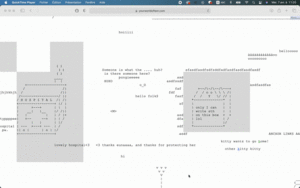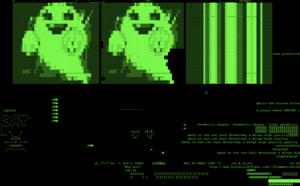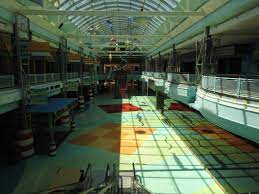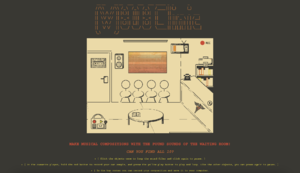User:Kendal/Project Proposal: Difference between revisions
(Created page with "==What do you want to make?== General introduction ==How do you plan to make it?== Describe how you will go about conducting your research through reading, writing and prac...") |
|||
| (34 intermediate revisions by the same user not shown) | |||
| Line 1: | Line 1: | ||
[[File:Asciimap.gif|thumb|right|Your World of Text Now]] | |||
[[File:Ywotarchive.png|thumb|right|Your World of Text Archive 2016]] | |||
==Editable Pad== | |||
<br> https://pad.xpub.nl/p/klbprojectproposal | |||
==What do you want to make?== | ==What do you want to make?== | ||
Abandoned online platforms tell us a story of a forgotten past. I want to create an office that uses methods of community outreach and software evangelicalism to convert and tell stories of these spaces. The office will host a range of projects (virtual worlds - Habbo Hotel, social networks - SpaceHey & Your World of Text). I am interested in how these spaces fell foul to decay and want to showcase this not only as a static snapshot of the past while also attempting to intervene within them using the capabilities and affordances of the corresponding platform. To me, they represent remnants of previous ideas of the future of the Internet, and I believe there is a richness in the design and decisions that went into building them. | |||
Linking with these projects (SpaceHey, YWoT) directly, I aim to shed light on the motivations behind preservation and also create new audiences to engage with the environments as a way to escape the perils of a much more standardised internet landscape. Through a poetic presentation of these abandoned spaces, but also through the hosting of small interventions within them, I am refusing to abandon the disused. | |||
I am planning to build a physical office installation and website that both showcases the spaces, and explains what these early iterations of virtual spaces offer in a creative context. | |||
With standardisation and a push for standardisation of the internet, the online landscape has shifted from freeform hangouts to deliberate spaces that house very specific scenarios. For example, hyperrealistic virtual worlds, and massively surveilled social networks form the landscape of today's internet experience. Categorisation of the space, people and ideas block access to experiments that might not fit within these specific criteria and thus, proceed to be left abandoned and unused. Early fringe virtual communities on platforms such as Second Life, MySpace and Habbo Hotel were pushed out in favour of walled gardens like Facebook & Twitter. The digital spaces reflect a form of a non-place, spaces of transience, created with the idea of what the internet could be in the future. Instead these worlds were abandoned, however still online but vastly under-occupied. They become a series of fossils that could be investigated as a way to piece back together the abandoned histories of this digital landscape. | |||
Imagine a physical non-place like a mall. These spaces were created as a utopic glimpse into the future and now lay silent and dated, completely a product of the past but lay peacefully as archaeological sites. How can we take these digital equivalents as space for creative experiments and making whilst honouring the histories within? | |||
[[File:Deadmall.jpeg|thumb|center|Abandoned Mall]] | |||
==Planning== | |||
''December & January''<br> | |||
Research and gather the userspaces and affordances of each platform I plan to present. Map these using Twine to fully understand what it is I find interesting about each platform. This would involve locating and linking up with these communities online to understand the driving force of the preservation of these spaces. | |||
''January & February''<br> | |||
Create tests with the communities and prototype ways of inhabiting space on these platforms. This will also be the time in which I invite artists to intervene in these spaces and collect results. This would the moment of exploring the reappropriation of these spaces using the tools in which each individual space offers. | |||
''March''<br> | |||
Building the website and office environment using input from architectural examples. Also, ask for input from the audience. Start sketching the final design of the Bureau of Forgotten Futures. | |||
''May''<br> | |||
Finally, I need to gather the building materials and office supplies to build the complete office installation including a storefront. This would be imperative for introducing the alternative way of using the internet to the public. The reason I chose the format of a project-based office is that I want to employ the inherent features of a pre-existing format as a way to situate the audience. It is important for me that the project feels accessible and I think starting with a riff on a preexisting format is a way to make the visitor feel at ease. | |||
==Why do you want to make it?== | ==Why do you want to make it?== | ||
I want to chart the effect standardisation and categorisation has on the creative 'worlds' of the internet. I want to understand the shift between these highly imaginative and creative spaces of my childhood and the hyperrealistic virtual environments of today. Former platforms now feel like digital non-spaces, utopian ideas for a potential future, left abandoned. My project would be a way to explore the potentialities of these spaces and revisit the future for the forgotten. It is both a collective imagining and a collective action that I want to explore, can we bring back a creative community online? The goal is not to reinvent the wheel, but to cultivate these spaces we already have and give new affordances to them, all while taking into account the history of their forgotten futures. It is an exploration into reflective and restorative nostalgia and how this frames the need to revisit these spaces. | |||
With an interest in Net-Art, I want to explore the possibility of using these forgotten spaces as a medium through curating the spaces for works of digital art, while making use of what already exists. I want to make visible these unintentionally underground areas of the internet as an alternative to the options we have in our current online landscape. | |||
==Who can help you and how?== | ==Who can help you and how?== | ||
Alicia Framis (AMS) - Simulation as a method to present ideas, over-categorisation, architecture <br> | |||
Michael & Manetta (XPUB) - Practical help with website creation, feedback & conceptual development. <br> | |||
Atelier Adam Nathaniel Furman (UK) - architect who works in creating space for the other. <br> | |||
Florian Cramer (NL) - writer who has an extensive knowledge of media theory and forgotten platforms.<br> | |||
Virtual world developer- why are these spaces created this way, and what are the goals in the development <br> | |||
Josephine Bosma (AMS) - Extensive knowledge in Net-Art. <br> | |||
Restorativ.org - Collective that is archiving and publishing platforms that are no longer online.<br> | |||
SpaceHey- A group dedicated to creating a space online reminiscent of MySpace.<br> | |||
== Relation to previous practice == | == Relation to previous practice == | ||
My previous practice is heavily influenced by the forgotten and fringe spaces of both the virtual and physical worlds. I am interested in the effects of standardisation and how time shifts, resulting often in abandoned ideas, buildings and promises. Previously I have explored the concept of Non-Places in the physical world and want to find the digital equivalent. In a previous special issue (#14) I created a game that used the forgotten audio aspects of a non-place (a doctor's waiting room) and instead used these audio components as ingredients to play and create new compositions. I wanted to explore using the preexisting and find the affordances of the space. I am interested in restructuring these spaces in a way to reignite the imagination and serve as a new medium for publishing works. | |||
[[File:W808.png| thumb|center|W808]] | |||
One of my earlier projects was to create a 3D online exhibition space to counter the growing number of graduates from a Brighton art school that were finding it increasingly difficult to find places to exhibit their works in the highly competitive art industry of London and beyond. This ignited my interest in the online space as an alternative for artistic projects. | |||
<center><gallery> | |||
File:Emulate1.png | |||
File:Emulateexhib.png | exhibition text | |||
File:Emulate2.png | |||
</gallery></center> | |||
== Relation to a larger context == | |||
My project is situated in many fields, it takes ideas from situationism, specifically play, non-places in architecture and also can be viewed as a practice of media archaeology. While it uses my background in architecture as a starting point, it extends the concept to virtual world architecture, worlding and the anthropological study of space, It can help us rethink the capabilities of platforms long forgotten and give purpose to pre-existing spaces instead of the constant saturation of new worlds. It is what I feel is the next step of projects such as Space Hey & Restorativ.org which mostly aim to archive the forgotten, my extra step would be to temporarily give these spaces new life in order to tell the story of these platforms. | |||
== References == | |||
Benjamin, W. and Eiland, H. (2003). The Arcades Project. Cambridge, Ma: The Belknap Pr. Of Harvard Univ. Pr.<br> | |||
Bowker, G.C. and Susan Leigh Star (2008). Sorting things out : classification and its consequences. Cambridge, Mass.: Mit Press<br> | |||
Buerger, M., Dragan Espenschied, Olia Lialina and Merz-Akademie (2009). Digital folklore. Stuttgart: Merz & Solitude.<br> | |||
Castronova, E. (2007). Synthetic worlds : the business and culture of online games. Chicago: University Of Chicago Press.<br> | |||
Chiang, T. (2010). The Lifecycle of Software Objects. Burton, Mi: Subterranean Press.<br> | |||
Critical Art Ensemble (1998). Flesh machine : cyborgs, designer babies, eugenic conscousness. Brooklyn, N.Y.: Autonomedia.<br> | |||
Dekker, A, Wolfsberger, A. and Virtueel Platform (Amsterdam (2009). Walled Garden. Amsterdam: Virtueel Platform.<br> | |||
Gabrys, J. (2013). Digital rubbish a natural history of electronics. Ann Arbor, Mich. Univ. Of Michigan Press.<br> | |||
Hertz, G. and Parikka, J. (2012). Zombie Media: Circuit Bending Media Archaeology into an Art Method. Leonardo, 45(5), pp.424–430.<br> | |||
Müllner, L. (2018). Operation Jane Walk. [online] Vimeo. Available at: https://vimeo.com/301933682 [Accessed 21 Nov. 2021].<br> | |||
Pol, V.D.B (2017). School of Missing Studies. Berlin: Sternberg Press.<br> | |||
preservingworlds.net. (n.d.). Preserving Worlds. [online] Available at: https://preservingworlds.net/index.html [Accessed 22 Nov. 2021].<br> | |||
Rheingold, H. (2000). The virtual community : homesteading on the electronic frontier. Cambridge, Mass.: Mit Press.<br> | |||
Turkle, S. and Schuster, S. (2014). Life on the screen : identity in the age of the Internet. New York: Simon & Schuster Paperbacks, Dr. | |||
Latest revision as of 15:52, 7 December 2021
Editable Pad
https://pad.xpub.nl/p/klbprojectproposal
What do you want to make?
Abandoned online platforms tell us a story of a forgotten past. I want to create an office that uses methods of community outreach and software evangelicalism to convert and tell stories of these spaces. The office will host a range of projects (virtual worlds - Habbo Hotel, social networks - SpaceHey & Your World of Text). I am interested in how these spaces fell foul to decay and want to showcase this not only as a static snapshot of the past while also attempting to intervene within them using the capabilities and affordances of the corresponding platform. To me, they represent remnants of previous ideas of the future of the Internet, and I believe there is a richness in the design and decisions that went into building them.
Linking with these projects (SpaceHey, YWoT) directly, I aim to shed light on the motivations behind preservation and also create new audiences to engage with the environments as a way to escape the perils of a much more standardised internet landscape. Through a poetic presentation of these abandoned spaces, but also through the hosting of small interventions within them, I am refusing to abandon the disused. I am planning to build a physical office installation and website that both showcases the spaces, and explains what these early iterations of virtual spaces offer in a creative context.
With standardisation and a push for standardisation of the internet, the online landscape has shifted from freeform hangouts to deliberate spaces that house very specific scenarios. For example, hyperrealistic virtual worlds, and massively surveilled social networks form the landscape of today's internet experience. Categorisation of the space, people and ideas block access to experiments that might not fit within these specific criteria and thus, proceed to be left abandoned and unused. Early fringe virtual communities on platforms such as Second Life, MySpace and Habbo Hotel were pushed out in favour of walled gardens like Facebook & Twitter. The digital spaces reflect a form of a non-place, spaces of transience, created with the idea of what the internet could be in the future. Instead these worlds were abandoned, however still online but vastly under-occupied. They become a series of fossils that could be investigated as a way to piece back together the abandoned histories of this digital landscape.
Imagine a physical non-place like a mall. These spaces were created as a utopic glimpse into the future and now lay silent and dated, completely a product of the past but lay peacefully as archaeological sites. How can we take these digital equivalents as space for creative experiments and making whilst honouring the histories within?
Planning
December & January
Research and gather the userspaces and affordances of each platform I plan to present. Map these using Twine to fully understand what it is I find interesting about each platform. This would involve locating and linking up with these communities online to understand the driving force of the preservation of these spaces.
January & February
Create tests with the communities and prototype ways of inhabiting space on these platforms. This will also be the time in which I invite artists to intervene in these spaces and collect results. This would the moment of exploring the reappropriation of these spaces using the tools in which each individual space offers.
March
Building the website and office environment using input from architectural examples. Also, ask for input from the audience. Start sketching the final design of the Bureau of Forgotten Futures.
May
Finally, I need to gather the building materials and office supplies to build the complete office installation including a storefront. This would be imperative for introducing the alternative way of using the internet to the public. The reason I chose the format of a project-based office is that I want to employ the inherent features of a pre-existing format as a way to situate the audience. It is important for me that the project feels accessible and I think starting with a riff on a preexisting format is a way to make the visitor feel at ease.
Why do you want to make it?
I want to chart the effect standardisation and categorisation has on the creative 'worlds' of the internet. I want to understand the shift between these highly imaginative and creative spaces of my childhood and the hyperrealistic virtual environments of today. Former platforms now feel like digital non-spaces, utopian ideas for a potential future, left abandoned. My project would be a way to explore the potentialities of these spaces and revisit the future for the forgotten. It is both a collective imagining and a collective action that I want to explore, can we bring back a creative community online? The goal is not to reinvent the wheel, but to cultivate these spaces we already have and give new affordances to them, all while taking into account the history of their forgotten futures. It is an exploration into reflective and restorative nostalgia and how this frames the need to revisit these spaces.
With an interest in Net-Art, I want to explore the possibility of using these forgotten spaces as a medium through curating the spaces for works of digital art, while making use of what already exists. I want to make visible these unintentionally underground areas of the internet as an alternative to the options we have in our current online landscape.
Who can help you and how?
Alicia Framis (AMS) - Simulation as a method to present ideas, over-categorisation, architecture
Michael & Manetta (XPUB) - Practical help with website creation, feedback & conceptual development.
Atelier Adam Nathaniel Furman (UK) - architect who works in creating space for the other.
Florian Cramer (NL) - writer who has an extensive knowledge of media theory and forgotten platforms.
Virtual world developer- why are these spaces created this way, and what are the goals in the development
Josephine Bosma (AMS) - Extensive knowledge in Net-Art.
Restorativ.org - Collective that is archiving and publishing platforms that are no longer online.
SpaceHey- A group dedicated to creating a space online reminiscent of MySpace.
Relation to previous practice
My previous practice is heavily influenced by the forgotten and fringe spaces of both the virtual and physical worlds. I am interested in the effects of standardisation and how time shifts, resulting often in abandoned ideas, buildings and promises. Previously I have explored the concept of Non-Places in the physical world and want to find the digital equivalent. In a previous special issue (#14) I created a game that used the forgotten audio aspects of a non-place (a doctor's waiting room) and instead used these audio components as ingredients to play and create new compositions. I wanted to explore using the preexisting and find the affordances of the space. I am interested in restructuring these spaces in a way to reignite the imagination and serve as a new medium for publishing works.
One of my earlier projects was to create a 3D online exhibition space to counter the growing number of graduates from a Brighton art school that were finding it increasingly difficult to find places to exhibit their works in the highly competitive art industry of London and beyond. This ignited my interest in the online space as an alternative for artistic projects.
Relation to a larger context
My project is situated in many fields, it takes ideas from situationism, specifically play, non-places in architecture and also can be viewed as a practice of media archaeology. While it uses my background in architecture as a starting point, it extends the concept to virtual world architecture, worlding and the anthropological study of space, It can help us rethink the capabilities of platforms long forgotten and give purpose to pre-existing spaces instead of the constant saturation of new worlds. It is what I feel is the next step of projects such as Space Hey & Restorativ.org which mostly aim to archive the forgotten, my extra step would be to temporarily give these spaces new life in order to tell the story of these platforms.
References
Benjamin, W. and Eiland, H. (2003). The Arcades Project. Cambridge, Ma: The Belknap Pr. Of Harvard Univ. Pr.
Bowker, G.C. and Susan Leigh Star (2008). Sorting things out : classification and its consequences. Cambridge, Mass.: Mit Press
Buerger, M., Dragan Espenschied, Olia Lialina and Merz-Akademie (2009). Digital folklore. Stuttgart: Merz & Solitude.
Castronova, E. (2007). Synthetic worlds : the business and culture of online games. Chicago: University Of Chicago Press.
Chiang, T. (2010). The Lifecycle of Software Objects. Burton, Mi: Subterranean Press.
Critical Art Ensemble (1998). Flesh machine : cyborgs, designer babies, eugenic conscousness. Brooklyn, N.Y.: Autonomedia.
Dekker, A, Wolfsberger, A. and Virtueel Platform (Amsterdam (2009). Walled Garden. Amsterdam: Virtueel Platform.
Gabrys, J. (2013). Digital rubbish a natural history of electronics. Ann Arbor, Mich. Univ. Of Michigan Press.
Hertz, G. and Parikka, J. (2012). Zombie Media: Circuit Bending Media Archaeology into an Art Method. Leonardo, 45(5), pp.424–430.
Müllner, L. (2018). Operation Jane Walk. [online] Vimeo. Available at: https://vimeo.com/301933682 [Accessed 21 Nov. 2021].
Pol, V.D.B (2017). School of Missing Studies. Berlin: Sternberg Press.
preservingworlds.net. (n.d.). Preserving Worlds. [online] Available at: https://preservingworlds.net/index.html [Accessed 22 Nov. 2021].
Rheingold, H. (2000). The virtual community : homesteading on the electronic frontier. Cambridge, Mass.: Mit Press.
Turkle, S. and Schuster, S. (2014). Life on the screen : identity in the age of the Internet. New York: Simon & Schuster Paperbacks, Dr.







